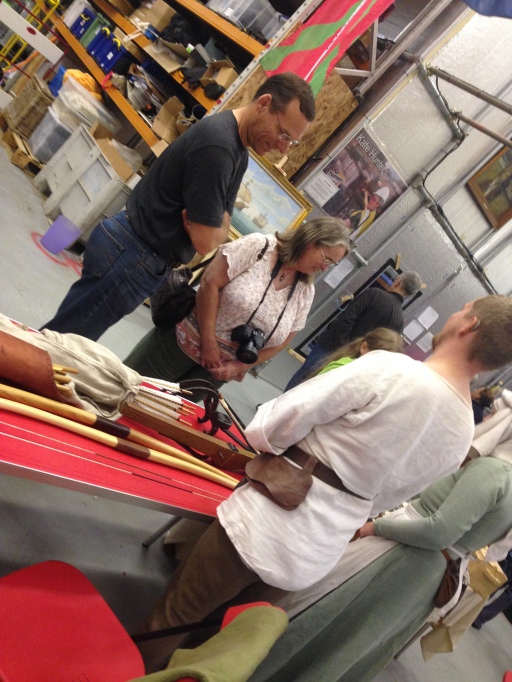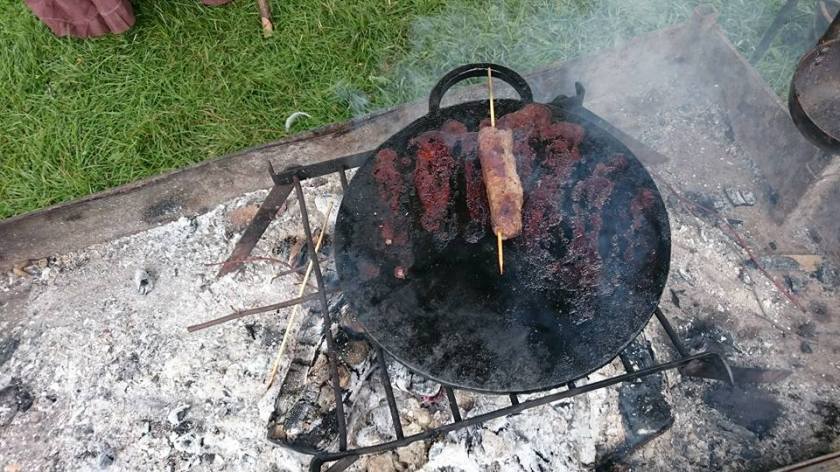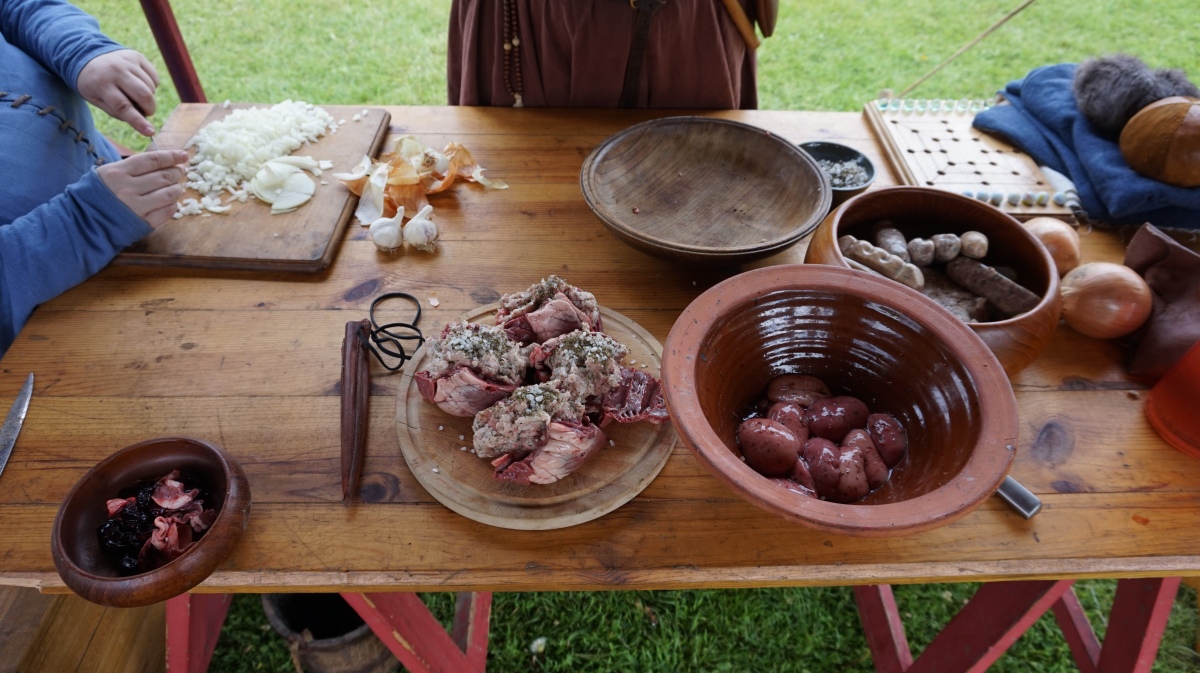Cardiff Castle Garrison provides an authentic hot lunch cooked in our living history camp at many of our shows. For anyone interested in trying their hand at cooking for the group, or those who’d like to know a bit more about cooking authentically in camp, read on!
Category: Living History
Guide: Modern foods unavailable in 14th Century Britain
Following on from our camp cooking guide, here is a list of common modern foods which were unavailable in fourteenth-century Britain. This list is by no means comprehensive, but is intended to cover most of the basics.
Continue reading “Guide: Modern foods unavailable in 14th Century Britain”
Tutorial: Women’s footed hose
I’ve been re-enacting since 2002, and have made cotes, shifts, veils, hoods and surcotes. I have had a go at making almost every piece of standard feminine soft kit except hose! I had always been a little intimidated by footed hose. Every time I had looked into making some I saw tutorials which required so many measurements – 26 in one version – or required a complex pattern which I wasn’t happy scaling up to my big feet.
Adopted Russian
Last year I was introduced to Jana Romanova, an artist who wanted to participate in the activities of Welsh communities as part of a piece exploring the nature of belonging and of Welshness. She wanted to join the Garrison for an event or two to immerse herself in our community and explore historic Welshness.
Recipe: Stuffed lambs’ hearts
At Joust! we decided to have a go cooking some less popular cuts of meat. We went straight to the heart of the matter (ha!) and asked our local butcher for some offal-based options. He kindly donated us four lambs’ hearts.
What you’ll need:
- Some lambs hearts (we had four)
- Sausage meat – enough to fill the hearts to bursting.
- Rosemary
- Salt
- A bottle of ale (not lager!)
- A litre of water
The method:
- Cut into your lambs hearts and remove any congealed blood (this, if you have time can be mixed into stocks and pates). Make sure you cut out any overly tough muscle.
- Stuff the hearts with sausage meat.
- Roll the stuffed heart in a mixture of salt and rosemary.
- Put your water and ale (you can also use wine), into a cooking put. Heat, but do not allow to boil.
- Add the hearts to the pot.
- Cook at a warm, but not boiling temperature, for two hours.
- Voila – delicious tender stuffed lambs hearts!
One thing to consider if you are going to give this a try yourself, some of the sausage meat escaped in the pot – binding the hearts with strips of bacon would be an authentic and effective way of keeping it all together.
Happy cooking!
Recipe: A vegan dish for a medieval palate
While most medieval peasantry were not feasting on meat every meal, they probably didn’t cater for vegans either. Along with vegetables, a typical medieval diet in south Wales would have included a lot of cheese, eggs and fish.
However, that doesn’t mean there aren’t dishes we can create now to cater for vegan diets using ingredients available to people living in the 14th Century.
Over the August Bank Holiday we set up camp at the magnificent Caerphilly Castle.
One of the dishes I prepared on the Sunday was a lovely mushroom and lentil main. It’s very simple, tasty and easy to recreate at home.
What you’ll need:
- Half a kilo of mushrooms – I used traditional closed cap mushrooms but you can mix this up dependant on the strength of flavour you want
- Two cans of green lentils (you can soak lentils from a bag, but I’m a bit of a cheat)
- Quarter of a cup of olive oil
- A pinch of black pepper
- Mixed herbs (I used a combo of basil, rosemary and thyme)
These amounts serve 4-6 people. Halve the amounts for a good portion for two.
Method:
- Soak the lentils in half of the olive oil. Add in all of the black pepper and herbs. Mix together and leave for two hours
- Chop the mushrooms
- Heat the remainder of the olive oil in a pan over the hob/ barbeque/ fire pit
- Fry the mushrooms in the pan
- As they begin to go brown, add in the lentils
- Stir the mix together until it is warmed right through
- Serve
Delicious!
Show report: Newport Ship Open Day – August 2016
We were delighted to return to the Newport Ship this month for their open day. Now in their new warehouse, this medieval ship is being painstakingly preserved and studied. Five hundred timbers had returned from freeze-drying at the York Archaeological Trust only two days before, so it was great to have a look at the progressing work.

We set up a range of displays for the public to help interpret medieval life including archery, weapons, armour, crafts and music. It is always great to make links between our displays and the archaeology at hand. For example, in showing medieval spinning and wool processing we could relate this to the sheep wool (potentially of Merino type [Mulville and Hunter Zooarch JISCMail 2003]) and other animal products that were found in the ship’s caulking and luting material; these included raw fibres, dyed fibres and woven material which were used in sealing the timbers and plugging leaks (Jones 2013, 4 & 10). The ship also had a silver coin inserted into a cut out in the stempost/keel join, potentially placed as a token of good fortune at the start of the ship’s construction. A largely 15th century (and thus contemporary) token or badge consists of a coin sealed inside a pewter purse (Spencer 1998; Spencer 1990, 116-117, 134-135, Figures 311-314c). One interpretation of these finds is that a belief existed that carrying a token of wealth increased your chances of attracting wealth to you.
We look forward to seeing the ship’s continued conservation and reassembly!





Jones, T. 2013. S.O.S. News from the Friends of the Newport Ship, 21.
Spencer, B. 1998. Museum of London Medieval Finds from Excavations in London 7: Pilgrim Souvenirs and Secular Badges. London: The Stationery Office.
Spencer, B. 1990. Salisbury & South Wiltshire Museum Medieval Catalogue Part 2: Pilgrim Souvenirs & Secular Badges. Wiltshire: Salisbury & South Wiltshire Museum.
Recipe: Skewers and Greens
For the second day of Melee at Cardiff Castle I wanted to cook something quick and simple. I was inspired by “To the King’s Taste” (Lorna J. Sass 1975). Fresh summer vegetables are a frequent item in 14th century menus but there aren’t often recipes involving them as these dishes were too simple to be worth recording.
I used fresh carrots (found in the market by another member). These beautiful colours would have been usual to medieval people; orange carrots only became popular in the last couple of hundred years.

I chopped the carrots and put them to boil in a big pot over a fire of split logs with a little flame and a lot of embers to boil gently. I added salt to the water as with the group working outside all day a little extra salt is necessary.
While the carrots were cooking I started the meat. The sources suggest trimmings from preparing larger joints and offal be chopped very finely . As I was short of time I cheated (this may be a recurring theme) and used 1.6kg of beef mince. I seasoned it with salt, pepper, herbs and about two level tsp of Poudre Douce, a mild spice mix. Every good chef would have their own version of this popular seasoning but it often contained cinnamon, ginger, grains of paradise, nutmeg, sugar and galangal.

The meat was kneaded and shaped into sausages to put on the skewers. I soaked mine overnight so they didn’t catch fire. To cook the meat I put the bakestone over a fire of hot embers to heat up and used a little butter to grease it and check the temperature. When it was sizzling I put the first batch of skewers on to cook.

I added 1kg of frozen peas to the carrots and simmered them while I prepared the second batch of skewers. Once the first batch were browned all over I swapped the second batch on to cook, drained the veg and added spinach, rocket, butter and pepper to it. I put a lid over the veg and knocked the fire down to let it steam in the heat from the pan until the meat was done.

I served it up as fairly as possible to the twelve we had in camp on Sunday and everyone said they enjoyed it very much.
Recipe: A vegetarian-friendly medieval dish
Vegetarian friendly Medieval dish – Cheesy lentils
Jayne Lutwyche sometimes produces authentic medieval meals at our events, cooked over our fire. This recipe, and the stewed lambs’ hearts one which will follow it, were served at Joust! in June 2016.
As Medieval cooks it’s often difficult to find interesting, veggie friendly meals which aren’t pottage-based. Last season we were experimenting with a great dish, which was simple, quick to cook, and delicious.
All you need are:
- Lentils and/or chickpeas
- Cheese – preferably a veggie friendly one (that’s without rennet!)
- Black pepper
The amount you need varies, depending on how many are in your camp. But a rough two-to-one ratio lentils:cheese works.
- To prepare your dish soak your lentils/chickpeas the night before (alternatively buy canned versions, and ensure you store them in something authentic whilst in camp)
- Slice your cheese – as fine as you can as this helps it melt. Chunks also work.
- Get a mortar and pestle and grind a few pinches of black pepper. Other spices can be used – I’ve seen cinnamon recommended to give it a bit of an authentic kick.
- Add your cheese and lentils to a pot. To be very authentic consider using ceramic and placing it in the ashes of your camp fire. If you can’t do this a metal cauldron or pot will do.
- Stir occasionally, mixing in your pepper and spices.
- Cooking time is approximately 20 minutes.
Voila! Delicious – non-pottage – veggie dish or side.
Sewing workshop with Christine Carnie, The Sempster
Members of Cardiff Castle Garrison set up and attended a sewing workshop by Christine Carnie, aka ‘The Sempster’, one of the UK’s leading experts in making historical clothing using period techniques. The workshop was both fun and extremely valuable, with everyone who attended coming away with a great deal of information on authentic stitching techniques, and how and when to use them. Take a look at our day and some of the things we learned…
Authentic stitches
Unfortunately, there are few surviving seams in the extant garments that we have, due to several factors, including decay and in some cases bad treatment from archaeologists. There are, however, some details that have been deduced from what exists:
- It was likely that seams were often stitched in linen thread, due to the fact that wool usually survives where linen does not and seams are not present where the wool garments are preserved. There is, however, also evidence for seams sewn with woollen and silk thread.
- Stitches are usually tiny, to the point that they are hard or impossible to see, with stitch lengths of around 2 mm each, placed 2 mm apart. This is a good stitch length to aim form when sewing medieval garments, even if it does take some practice to achieve.
- When hand-sewing, it is common for re-enactors to sew most of their seams using backstitch, and then flat-fell the seam allowance afterwards. While this can be effective, backstitched seams are not as common in the medieval period, and there are many different examples of seam-sewing methods which vary depending on the fabric used.
Christine was kind enough to show us a wide variety of examples based on historical finds which are appropriate for a variety of fabric types. Two very useful types are featured here:
A Seam For Wool
A simple and authentic seam used for attaching two pieces of woollen fabric: a running-stitched seam with both seam allowances then whip-stitched to the underlying fabric.
Christine pointed out that in her experience most 14th Century garments will hold very nicely using this technique, and that using backstitch to join the stitches often holds the seam too tightly which can lead to the fabric tearing when it’s placed under strain, rather than the stitching. Using running stitch is also more time and thread efficient.
Note: If you are using wool pulled from the fabric as thread, remember that this works perfectly on wool that has been woven with a higher-twist thread, but most soft wools nowadays are woven with a very fluffy thread, which will break easily, and a felted wool will make it very difficult to pull out a thread. If you have a non-fulled fabric, it should work very well.
A Linen Seam
Authentic seam suitable for joining two pieces of linen: a seam sewn with running stitch, then the seam allowances folded together and whip stitched down.
This seam is particularly helpful for making underwear as in the fourteenth century there is usually little strain on underwear seams, and it binds the fraying-prone linen fabric edges in nicely.
Buttons and buttonholes
Buttons were all the rage in the fourteenth century, and Christine showed us a helpful method for producing both buttons and buttonholes. Check out her video here to see the construction technique…
Christine’s workshop was an extremely valuable experience for those who attended it, and Christine and her work come thoroughly recommended by the Garrison.
Christine Carnie – The Sempster
Christine is available for talks and courses on historical clothing and dressmaking, and also accepts commissions for historical clothing. Her Facebook page has some wonderful pictures and videos of the techniques featured in this article, along with many more examples from across history.
She focusses on the mid-13th to early 17th century clothing of common people, and makes all of her garments herself.




















